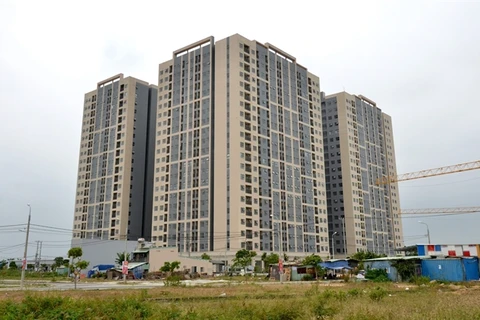Hanoi (VNS/VNA) – Increasing costs for credit risk provisions made many commercial banks’ profits decline in the third quarter of 2023.
The ratio of bad debt to total outstanding loans of ABBank as of the end of September 2023 was at 3.51%, a sharp increase compared to 2.88% at the beginning of this year. In particular, outstanding loans in Group 3 (substandard debts) and Group 4 (doubtful debts) both doubled over the past nine months.
ABBank's credit risk provision costs therefore also increased by more than 99% over the same period last year, reaching nearly 1.05 trillion VND (43,000 USD). The rise eroded ABBank's profits, bringing the bank’s total pre-tax profits down to just more than 708 billion VND, down 59% compared to the first nine months of 2022.
It is the same at Techcombank, where the ratio of bad debts to total outstanding loans was 1.4% against 0.9% by the end of 2022.
Techcombank in Q3 2023 set aside some 2.28 trillion VND for credit risk provision, an increase of nearly 84% compared to the same period in 2022. The bank’s pre-tax profits therefore decreased by 17.8% over the same period to more than 17.11 trillion VND.
Meanwhile, TPBank aggressively spent nearly 2 trillion VND on risk provisions in the past nine months, an increase of 14% over the same period last year. Of which, in the third quarter of 2023 alone, TPBank set aside up to 1.29 trillion VND, four times higher than the same period in 2022. TPBank's post-tax profit in Q3 2023 decreased by 26.3% over the same period to more than 1.57 trillion VND. Accumulated for the first nine months of 2023, the bank’s pre-tax profit decreased by 16.3% to 4.96 trillion VND.
The reason why TPBank made such a strong credit risk provision is that the bank's bad debt in the past nine months increased dramatically to more than 5.35 trillion VND, four times higher than at the beginning of the year, of which the sharpest debt increase was in Group 3 and 4 (8.5 times and 3 times, respectively) compared to the beginning of the year. Therefore, the bad debt ratio at TPBank increased from 0.84% at the beginning of this year to 2.97% at the end of September 2023.
Viet Capital Bank is no exception, as its pre-tax profit in the third quarter of 2023 reached more than 21 billion, down 69.3% over the same period last year. Accumulated for the first nine months of 2023, Viet Capital Bank recorded a post-tax profit of only 61 billion VND, down 85.6% over the same period last year.
Besides a decline in main revenue sources, an increase in credit risk provision also contributed to dragging down Viet Capital Bank's profits. By the end of the third quarter of 2023, the bank spent more than 141 billion VND on credit risk provision, an increase of 15% over the same period last year. The bank's bad debt ratio increased from 2.79% at the beginning of this year to 3.56%, exceeding the 3% regulatory cap set by the State Bank of Vietnam.
The increase in provision costs of banks in recent quarters was forecast previously as the sharp increase in bad debt of firms, especially in the real estate and export sectors.
Tran Thi Khanh Hien, director of MB Securities Company (MBS)’s research division, forecast that banks' provision costs will continue to increase in the fourth quarter of 2023 as banks are trying to write off bad debts and reduce the bad debt ratio to below 3% by the end of 2023. This will continue to put pressure on banks' profits.
Forecasting bank profits for the last quarter of this year, Tran Ngoc Bau, general director of financial data and technology firm WiGroup, believed the operating costs of banks will increase sharply in Q4 2023 due to seasonal factors. This, along with the possibility that provision costs may continue to increase, will cause banks' profits in Q4 2023 to be lower than in Q3 2023. However, compared to the same period last year, profits of the banking industry will likely stay flat or inch down.
Furthermore, credit growth, one of the important factors affecting banks' profits, is still quite far from the central bank’s target. According to data from the SBV, as of October 27, 2023, credit growth only reached 7.1%, much lower than the target of 14-15% set for the whole year.
Besides, low capital demands of firms and people amid the unclear recovery outlook of consumer production industries, Hiền attributed the low credit growth to the reason that banks have to be more cautious with their lending decisions and tighten credit standards to maintain credit quality as the bad debt ratio has exceeded 3%.
The State Bank of Vietnam (SBV) reported as of July 2023, the bad debt ratio on banks’ balance sheet was at 3.56%, higher than 2% at the end of 2022. If including debts that banks sold to the Vietnam Asset Management Company (VAMC) and have not yet processed and recovered, the total bad debt ratio of the banking system was at 6.16%.
According to SBV Governor Nguyen Thi Hong, bad debt handling is still facing many difficulties because firms are suffering from negative impacts due to global uncertainties, which has caused a reduction in their solvency.
The legal framework related to restructuring credit institutions and handling bad debts has not been completed. The country is also lacking preferential policies to encourage domestic and foreign investors to participate in settling mortgaged assets and trading bad debts.
Nguyen Huu Huan, head of HCM City Economics University’s Financial Markets Department, proposed that to reduce bad debt pressure and to clear the flow of capital in the economy, the Government needs to focus on promoting more fiscal policy, as the disbursement of public investment capital has not been as expected to date./.
The ratio of bad debt to total outstanding loans of ABBank as of the end of September 2023 was at 3.51%, a sharp increase compared to 2.88% at the beginning of this year. In particular, outstanding loans in Group 3 (substandard debts) and Group 4 (doubtful debts) both doubled over the past nine months.
ABBank's credit risk provision costs therefore also increased by more than 99% over the same period last year, reaching nearly 1.05 trillion VND (43,000 USD). The rise eroded ABBank's profits, bringing the bank’s total pre-tax profits down to just more than 708 billion VND, down 59% compared to the first nine months of 2022.
It is the same at Techcombank, where the ratio of bad debts to total outstanding loans was 1.4% against 0.9% by the end of 2022.
Techcombank in Q3 2023 set aside some 2.28 trillion VND for credit risk provision, an increase of nearly 84% compared to the same period in 2022. The bank’s pre-tax profits therefore decreased by 17.8% over the same period to more than 17.11 trillion VND.
Meanwhile, TPBank aggressively spent nearly 2 trillion VND on risk provisions in the past nine months, an increase of 14% over the same period last year. Of which, in the third quarter of 2023 alone, TPBank set aside up to 1.29 trillion VND, four times higher than the same period in 2022. TPBank's post-tax profit in Q3 2023 decreased by 26.3% over the same period to more than 1.57 trillion VND. Accumulated for the first nine months of 2023, the bank’s pre-tax profit decreased by 16.3% to 4.96 trillion VND.
The reason why TPBank made such a strong credit risk provision is that the bank's bad debt in the past nine months increased dramatically to more than 5.35 trillion VND, four times higher than at the beginning of the year, of which the sharpest debt increase was in Group 3 and 4 (8.5 times and 3 times, respectively) compared to the beginning of the year. Therefore, the bad debt ratio at TPBank increased from 0.84% at the beginning of this year to 2.97% at the end of September 2023.
Viet Capital Bank is no exception, as its pre-tax profit in the third quarter of 2023 reached more than 21 billion, down 69.3% over the same period last year. Accumulated for the first nine months of 2023, Viet Capital Bank recorded a post-tax profit of only 61 billion VND, down 85.6% over the same period last year.
Besides a decline in main revenue sources, an increase in credit risk provision also contributed to dragging down Viet Capital Bank's profits. By the end of the third quarter of 2023, the bank spent more than 141 billion VND on credit risk provision, an increase of 15% over the same period last year. The bank's bad debt ratio increased from 2.79% at the beginning of this year to 3.56%, exceeding the 3% regulatory cap set by the State Bank of Vietnam.
The increase in provision costs of banks in recent quarters was forecast previously as the sharp increase in bad debt of firms, especially in the real estate and export sectors.
Tran Thi Khanh Hien, director of MB Securities Company (MBS)’s research division, forecast that banks' provision costs will continue to increase in the fourth quarter of 2023 as banks are trying to write off bad debts and reduce the bad debt ratio to below 3% by the end of 2023. This will continue to put pressure on banks' profits.
Forecasting bank profits for the last quarter of this year, Tran Ngoc Bau, general director of financial data and technology firm WiGroup, believed the operating costs of banks will increase sharply in Q4 2023 due to seasonal factors. This, along with the possibility that provision costs may continue to increase, will cause banks' profits in Q4 2023 to be lower than in Q3 2023. However, compared to the same period last year, profits of the banking industry will likely stay flat or inch down.
Furthermore, credit growth, one of the important factors affecting banks' profits, is still quite far from the central bank’s target. According to data from the SBV, as of October 27, 2023, credit growth only reached 7.1%, much lower than the target of 14-15% set for the whole year.
Besides, low capital demands of firms and people amid the unclear recovery outlook of consumer production industries, Hiền attributed the low credit growth to the reason that banks have to be more cautious with their lending decisions and tighten credit standards to maintain credit quality as the bad debt ratio has exceeded 3%.
The State Bank of Vietnam (SBV) reported as of July 2023, the bad debt ratio on banks’ balance sheet was at 3.56%, higher than 2% at the end of 2022. If including debts that banks sold to the Vietnam Asset Management Company (VAMC) and have not yet processed and recovered, the total bad debt ratio of the banking system was at 6.16%.
According to SBV Governor Nguyen Thi Hong, bad debt handling is still facing many difficulties because firms are suffering from negative impacts due to global uncertainties, which has caused a reduction in their solvency.
The legal framework related to restructuring credit institutions and handling bad debts has not been completed. The country is also lacking preferential policies to encourage domestic and foreign investors to participate in settling mortgaged assets and trading bad debts.
Nguyen Huu Huan, head of HCM City Economics University’s Financial Markets Department, proposed that to reduce bad debt pressure and to clear the flow of capital in the economy, the Government needs to focus on promoting more fiscal policy, as the disbursement of public investment capital has not been as expected to date./.
VNA

























